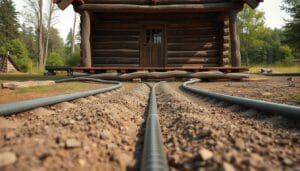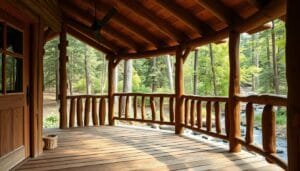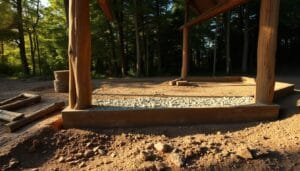More and more people who own a remote property are looking for ways to become energy independent. The dream of a self-sufficient lifestyle is a powerful motivator. This has led to a surge in exploring renewable energy solutions.
But is investing in one of these systems a smart move for your getaway? The answer isn’t simple. It depends on a lot of factors like your location, how much electricity you use, and your long-term goals.
This guide will walk you through the entire process. We’ll cover the basics and help you understand if this technology fits your situation. It’s not a one-size-fits-all answer, but a careful choice that can be brilliant for the right person.
Generating your own electricity is empowering. It offers practical benefits and the deep satisfaction of sustainable living. For detailed technical information, the Department of Energy’s guidebook is an excellent resource.
We’ll take a balanced look at the opportunities and challenges. Our goal is to help you make a fully informed decision about your property’s future.
Introduction to Wind Energy for Off-Grid Cabins
Modern technology has made harnessing nature’s forces a realistic goal for remote living. This section explores the core reasons for choosing these systems and how they stack up against each other.
Why Consider Renewable Energy?
Property owners are increasingly drawn to clean energy sources. The drive comes from a desire for energy independence, a smaller environmental footprint, and freedom from utility bills in isolated spots.
What was once a niche idea is now mainstream. Advances have made systems more efficient and affordable for average people. This is true for a primary residence or a weekend getaway.
Overview of Wind Versus Solar Options
Each renewable energy type has unique strengths. A turbine excels in areas with steady breeze, providing generation across different seasons, even at night.
Weather patterns often create a helpful balance. When the air is still, sunshine is usually abundant. This means solar panels can produce electricity on calm days.
This complementary relationship makes combining them a smart strategy. Relying on just one source for a whole home can be tricky. A hybrid approach offers more consistent results year-round.
How “wind power for off-grid cabin” Systems Work
At the heart of every self-sufficient property is a well-designed energy generation setup. It’s a team of components working together to capture nature’s force and turn it into a reliable resource.
Understanding Key Components: Turbines, Batteries, and Controllers
The turbine is the most visible part. Its blades spin a generator using strong, heat-resistant magnets. This creates the initial electrical current.
This raw electricity needs management. A smart controller, often an MPPT type, optimizes the flow. It ensures your batteries charge efficiently, even with a gentle breeze.
The batteries are the heart of storage. They save the generated energy for calm periods. Systems can use different voltages like 24V or 48V.
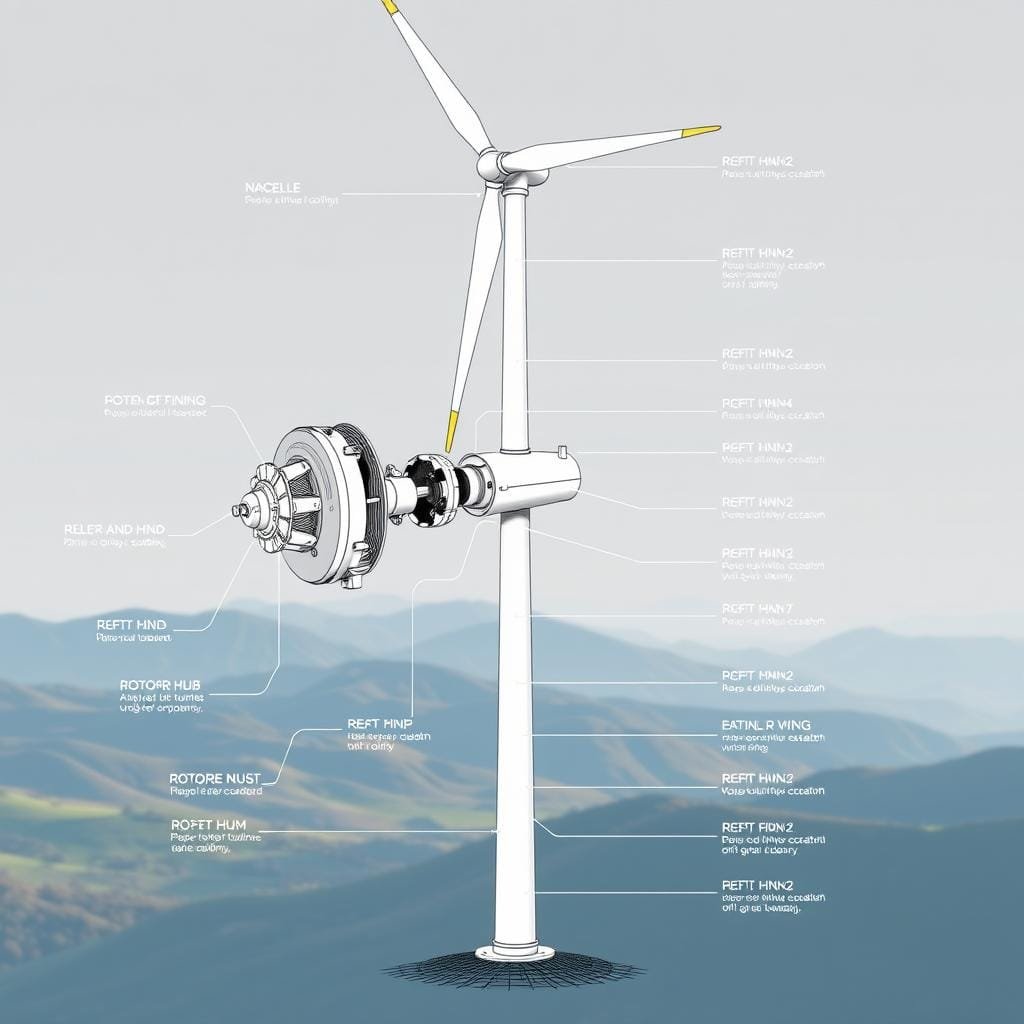
Essential Wind Speed and Performance Factors
A common myth is that you need a storm to make power. Most units begin generation at a low speed, around 6.7 mph. This is the start-up point.
The real performance shines at the rated speed. This is when the system hits its optimal output. High-speed ratings protect your electronics from voltage spikes during gusts.
| Wind Speed Metric | Typical Value | What It Means for Your System |
|---|---|---|
| Start-up Speed | 2-3 m/s (~6.7 mph) | The breeze strength needed to begin producing any electricity. |
| Rated Wind Speed | ~13 m/s (~29 mph) | The point where the turbine generates its maximum, optimal power. |
| Maximum Survival Speed | >35 mph | Ensures the entire setup can withstand extreme gusts without damage. |
Assessing Wind Resources and Site Considerations
The difference between a productive investment and an expensive yard ornament comes down to one thing: site assessment. You must have a consistent, strong breeze for the technology to work effectively.
Proper planning prevents poor performance. Taking the time to understand your local conditions is the best way to ensure success.
Evaluating Local Wind Patterns and Geography
Your property’s landscape plays a huge role. Features like tall trees or hills can block airflow. Conversely, open fields or ridges often channel and strengthen it.
Observe how trees bend during different seasons. This simple test reveals the prevailing direction and strength. Note which areas on your land feel the strongest consistent breezes.
Altitude is a major performance booster. Mounting your equipment higher gets it into stronger, smoother airflow. Always aim to clear nearby obstacles.
Tools and Resources for Measuring Wind Speeds
Start with free online tools for a general idea. The National Oceanic and Atmospheric Administration (NOAA) offers helpful maps. Websites like Windy.com provide visual forecasts.
Remember to check the units. Data may be in miles per hour (mph) or meters per second (m/s). Confusing them leads to big miscalculations.
These resources give a regional overview. Your specific spot might be different. For the most accurate data, consider a personal anemometer.
| Resource | Best For | Key Consideration |
|---|---|---|
| NOAA Wind Maps | Regional averages at 10m height | Good starting point, but not site-specific |
| Windy.com | Visual forecasts and real-time data | Shows patterns over time and anticipated weather |
| Personal Anemometer | Exact measurements at your location | Accounts for microclimates and local topography |
Modern systems include safety features for harsh weather. Some models automatically tilt to protect themselves from extreme gusts. A tower that can be lowered offers added security during storms.
If you’re going to make this investment, a thorough site check is non-negotiable. It saves money and frustration later.
Integrating Wind Turbines with Other Renewable Energy Solutions
Building a truly resilient energy setup for a remote property often means thinking beyond a single source. A hybrid approach combines different technologies to create a more dependable and consistent supply.
This strategy significantly reduces the risk of running out of electricity. When one source is weak, another is often strong.
Complementing Solar Panels and Other Power Sources
Solar panels are a natural partner for a turbine. Calm, sunny days are perfect for generating solar power, while windy, cloudy periods keep the other component active.
This complementary relationship is the core strength of a wind solar hybrid system. It smooths out the bumps caused by changing weather.
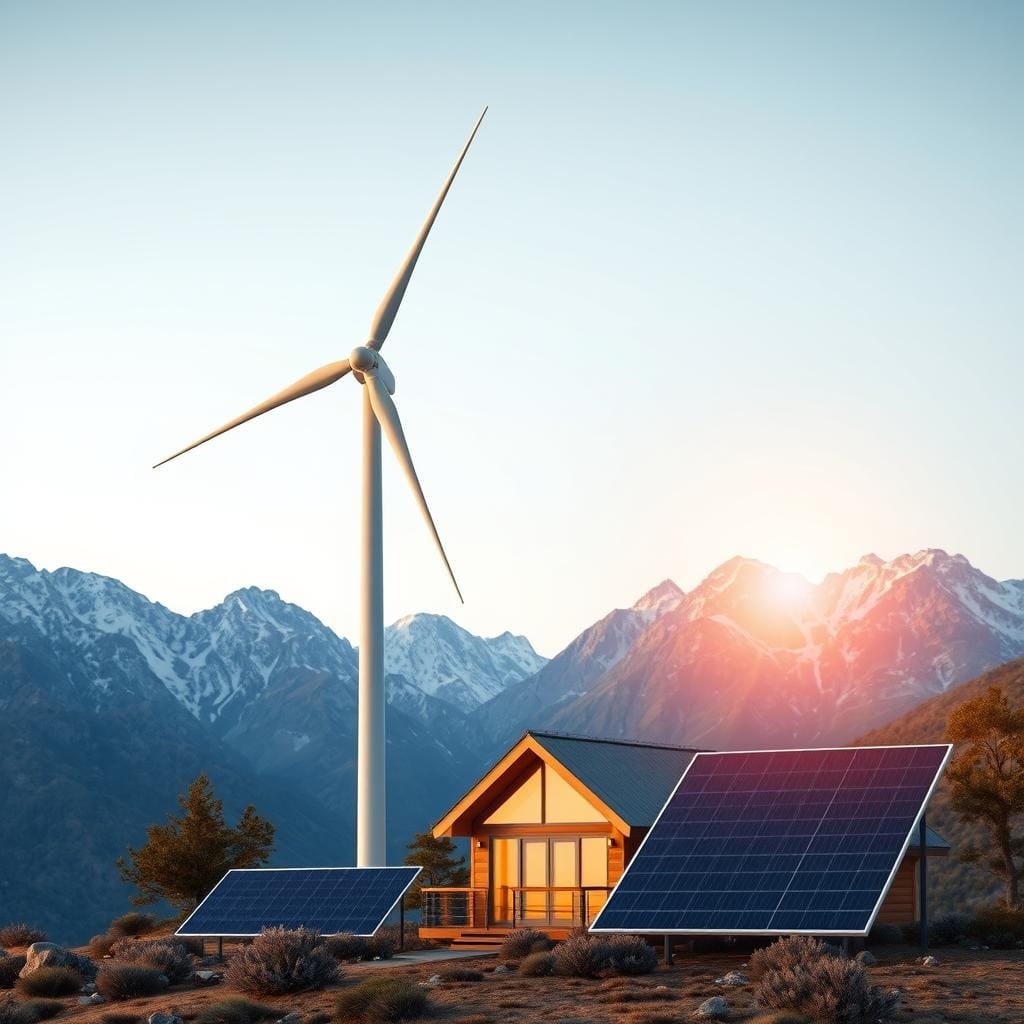
Complete packages are available that bundle these technologies. A typical setup might include several 100W panels alongside the turbine.
The heart of this integrated solar system is a hybrid MPPT controller. This smart device manages the flow from both sources to your batteries efficiently.
An inverter then converts the stored DC electricity into standard AC for your appliances. Common models range from 1500W to 3000W.
For major energy needs, consider alternatives. Heating a home with electric heat requires a massive amount of energy.
Many experienced owners use propane gas or a wood stove for winter warmth. Similarly, heating water with gas is far more practical than using an electric heater.
| High-Energy Appliance | Typical Renewable Load | Practical Alternative |
|---|---|---|
| Space Heating (HVAC) | Very High | Propane Gas or Wood Stove |
| Water Heater | Very High | Gas Water Heater |
| Kitchen Stove | High | Propane or Wood Cookstove |
Thoughtful integration creates a robust system. It’s not about complexity, but about building reliable energy independence for year-round comfort.
Step-by-Step Wind Turbine Installation Guide
A successful turbine project begins long before the equipment arrives at your property. Proper planning ensures your investment delivers reliable results for years to come.
Planning Your Setup and Necessary Permits
Start by calculating your electricity needs and assessing your site. Check local zoning regulations early—permits can take time. This groundwork prevents costly mistakes later.
Standard installation packages include everything you need. You’ll receive a complete turbine set with hub, blades, and generator. The package also contains an MPPT controller, mounting flange, and installation tools.
All components are brand new and thoroughly tested before shipping. Comprehensive systems add solar panels and LiFePO4 batteries. These come in various configurations like 12.8V 100AH for 12V setups.
Installation Tips and Safety Measures
Delivery typically takes 2-5 business days after payment. This means you could start assembling within a week. Always prioritize safety during the installation process.
Mount your equipment high enough to clear nearby obstacles. This dramatically improves performance. Consider towers that can be lowered during extreme weather conditions.
Proper battery bank setup is crucial. Ensure your MPPT controller matches your turbine’s output. Follow manufacturer specifications for all electrical connections.
You’re going to have expert support available. Manufacturers provide 2 years warranty and free technical assistance. Consulting with experienced team members can optimize placement for maximum efficiency.
Taking time to install correctly prevents a lot of frustration. A well-executed setup makes your renewable energy system pay off more quickly over the years.
Embracing a Sustainable Off-Grid Lifestyle
The journey toward energy independence often requires thoughtful choices about daily living. Your priorities shape what’s possible with renewable generation.
Powering a fully-equipped home demands substantial energy. Many successful owners use gas or wood for heating needs. This practical approach frees up electricity for other appliances.
Grid-tied systems offer a balanced solution. They provide reliable power during outages while reducing utility dependence. This hybrid approach works well for many people.
While the initial investment may seem significant, it pays off over years of ownership. The satisfaction of generating your own electricity creates a deeper connection to your property and values.
Whether you choose complete independence or a hybrid setup, proper planning ensures your system delivers comfortable, sustainable living through all seasons and weather conditions.
FAQ
Is a wind turbine a good choice for my remote cabin?
How much does a typical setup cost?
FAQ
Is a wind turbine a good choice for my remote cabin?
It can be a fantastic choice if you have consistent, strong breezes at your location. Turbines work well, especially at night and during cloudy weather when solar panels are less effective. For many, combining both energy sources creates the most reliable system for true energy independence.
How much does a typical setup cost?
A> Costs vary widely based on the size of the turbine and your energy needs. A small system might start around
FAQ
Is a wind turbine a good choice for my remote cabin?
It can be a fantastic choice if you have consistent, strong breezes at your location. Turbines work well, especially at night and during cloudy weather when solar panels are less effective. For many, combining both energy sources creates the most reliable system for true energy independence.
How much does a typical setup cost?
A> Costs vary widely based on the size of the turbine and your energy needs. A small system might start around $1,000, while a larger one capable of running more appliances could be several thousand. Don’t forget to factor in the price of deep-cycle batteries, a charge controller, and an inverter for a complete setup.
What’s the average lifespan of these systems?
A> With proper maintenance, a quality turbine can last 20 years or more. The batteries will need replacement more frequently, typically every 5 to 10 years, depending on the type and usage. Investing in good components upfront pays off over time.
Can I connect a wind generator to my existing solar panels?
A> Absolutely! This is a very popular and effective approach. You can use a hybrid charge controller, like an MPPT model, designed to handle input from both sources. This combination ensures you’re generating electricity from the sun during the day and from the wind at night, providing a more consistent power supply.
What maintenance is required?
A> Regular checks are key. You should periodically inspect the blades for damage, ensure all bolts are tight, and listen for unusual noises. Keeping the battery terminals clean and checking water levels in flooded lead-acid batteries are also essential tasks for long-term health.
Do I need a special permit to install one?
A> This depends entirely on your local regulations. Some areas have no restrictions, while others may require a permit, especially for taller towers. It’s crucial to check with your county building department before you purchase any equipment to avoid surprises.
,000, while a larger one capable of running more appliances could be several thousand. Don’t forget to factor in the price of deep-cycle batteries, a charge controller, and an inverter for a complete setup.
What’s the average lifespan of these systems?
A> With proper maintenance, a quality turbine can last 20 years or more. The batteries will need replacement more frequently, typically every 5 to 10 years, depending on the type and usage. Investing in good components upfront pays off over time.
Can I connect a wind generator to my existing solar panels?
A> Absolutely! This is a very popular and effective approach. You can use a hybrid charge controller, like an MPPT model, designed to handle input from both sources. This combination ensures you’re generating electricity from the sun during the day and from the wind at night, providing a more consistent power supply.
What maintenance is required?
A> Regular checks are key. You should periodically inspect the blades for damage, ensure all bolts are tight, and listen for unusual noises. Keeping the battery terminals clean and checking water levels in flooded lead-acid batteries are also essential tasks for long-term health.
Do I need a special permit to install one?
A> This depends entirely on your local regulations. Some areas have no restrictions, while others may require a permit, especially for taller towers. It’s crucial to check with your county building department before you purchase any equipment to avoid surprises.

